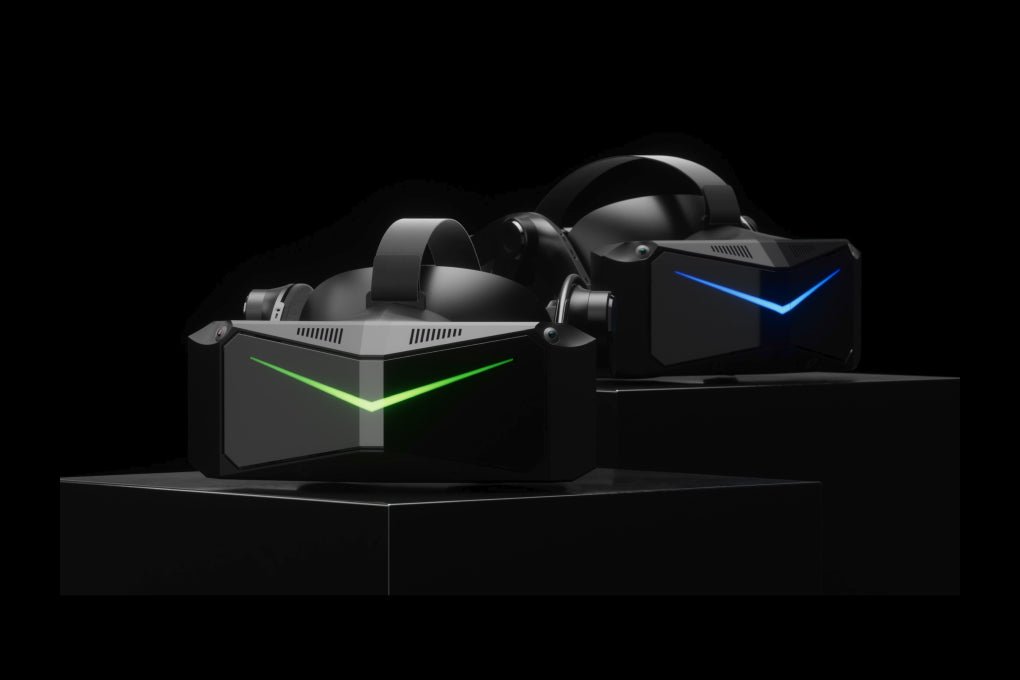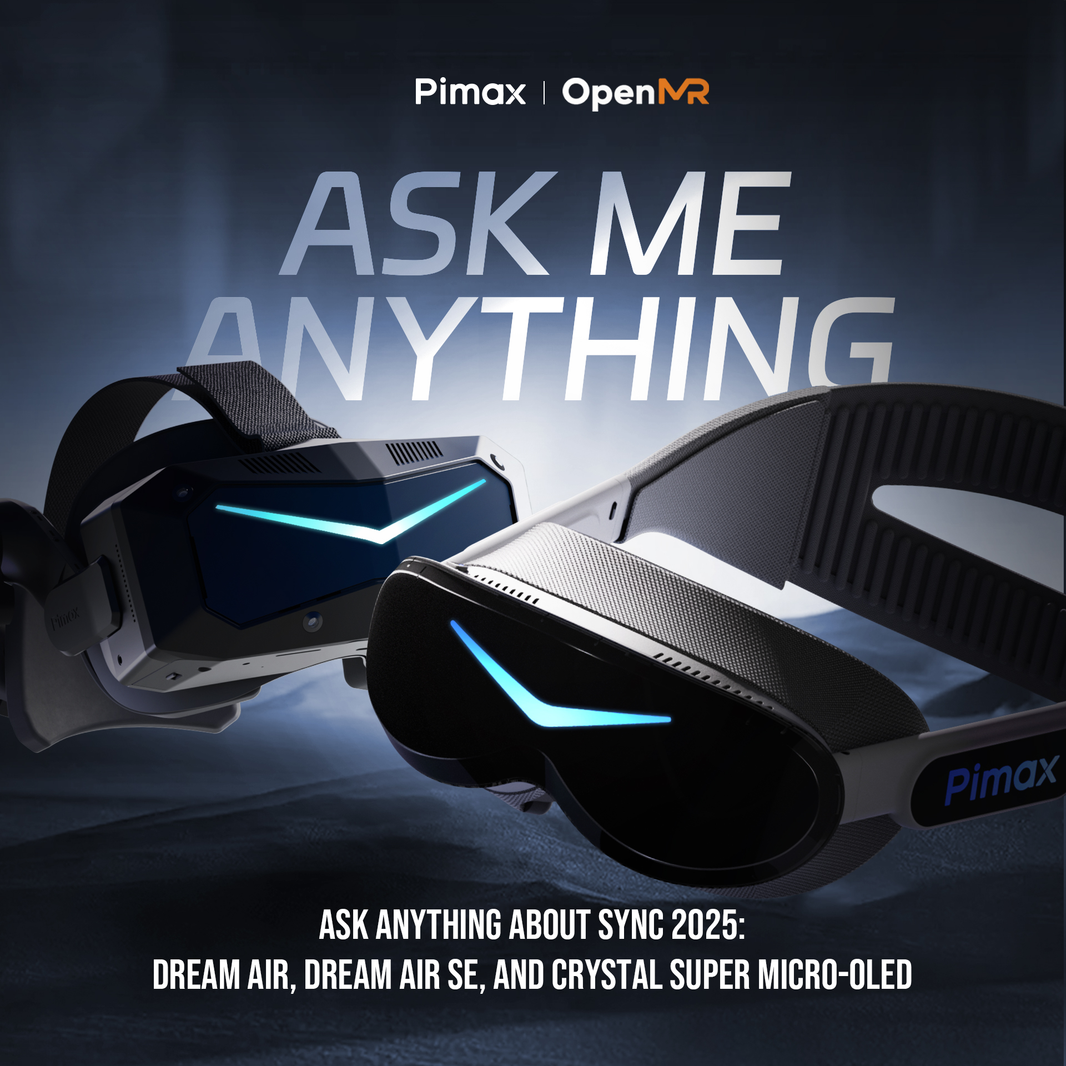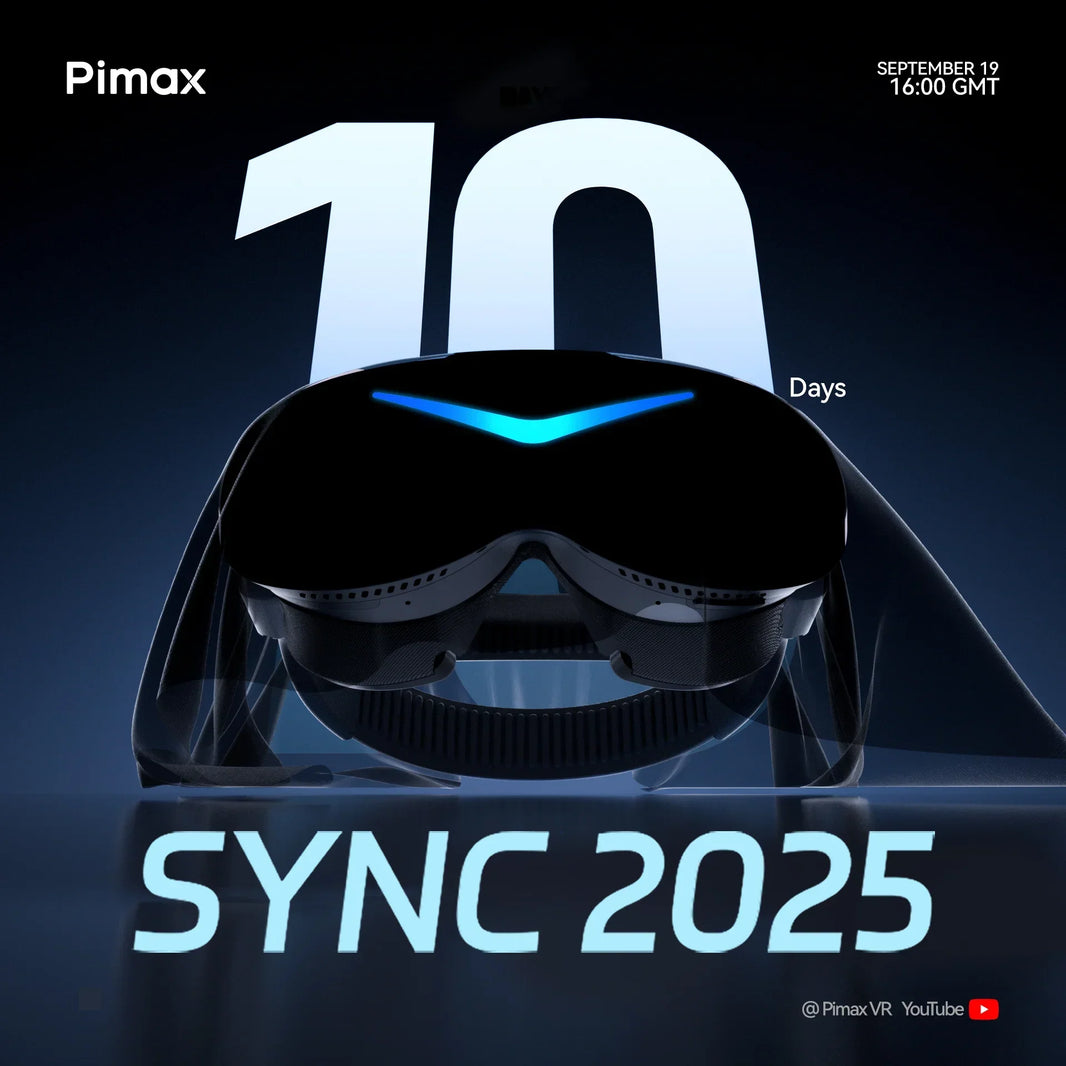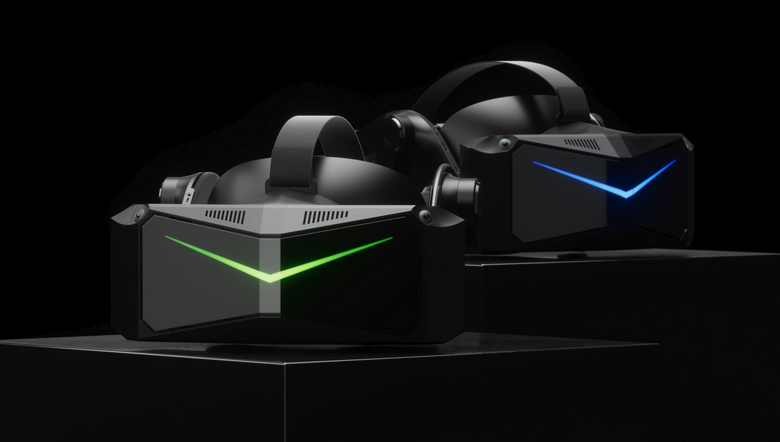
Pimax, known for its unique wide-field-of-view, high-resolution VR headsets, has announced the launch of its new products, Pimax Crystal Super and Pimax Crystal Light, in Japan.
The high-end model, Pimax Crystal Super, is a PC VR product that offers high resolution and high definition of up to 50-57 PPD at 8K (4K x 4K per eye), a wide viewing angle, and eye tracking support.
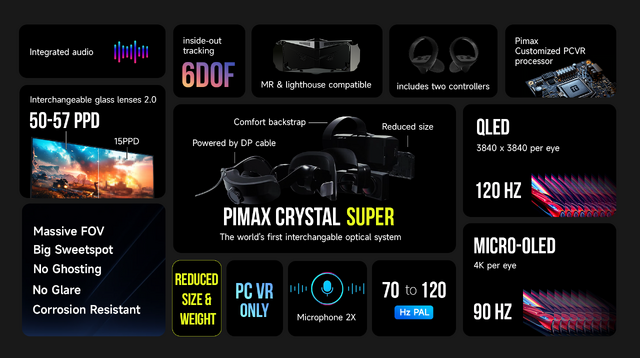
The entire optical engine, including the lens and display panel, can be removed and replaced, and the display can be chosen between OLED and QLED. The price is around 300,000 yen depending on the configuration, and it is scheduled to ship in the fourth quarter of 2024.
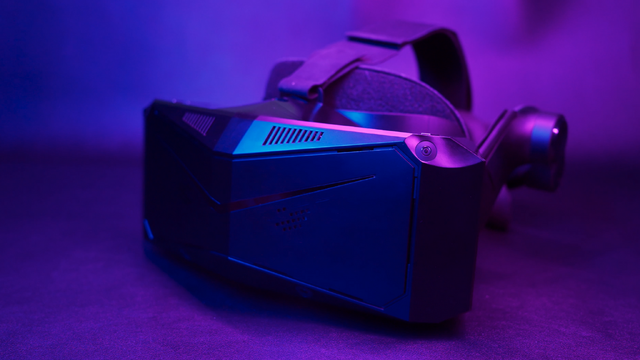
The other, Pimax Crystal Light, is based on the concept of high-end specifications at an affordable price.
This model offers high cost-effectiveness for its image quality, with 5.7K resolution (2880 x 2880 per eye), 35 PPD specifications, aspherical glass lenses inherited from higher-end models, and local dimming that turns off the backlight in dark areas to increase contrast. Pre-orders are being accepted for this model at around 140,000 yen, and it is scheduled to ship soon.
■The awesomeness of Pimax
Pimax is a Shanghai-based VR headset manufacturer. Founded in 2015, it is a long-established company (in the VR industry) and is known for its unique wide-field-of-view, high-resolution headsets.
To give you an idea of how unique it is, in 2016, when Oculus, the founder of the ongoing VR revival, was just releasing its first commercial 2K (1080 x 1200 per eye) model, the Oculus Rift CV1, the first 4K consumer model (2K x 2K per eye) attracted a lot of attention.
In 2019, Pimax 8K was launched, the first consumer-grade 8K TV with the extraordinary specs of 4K2K per eye and a 200-degree viewing angle.
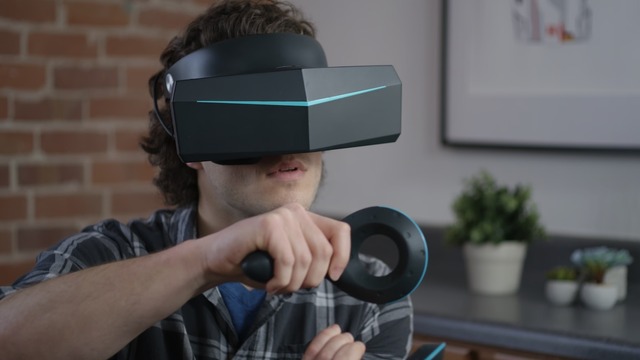
The field of view of a VR headset, or the width of the field of view, is determined by factors such as the availability of display panels, the lens configuration that makes the image appear wider, the graphics performance required for rendering (resolution and distortion correction), and the inevitable loss of detail when the image is stretched.Each company chooses a balance that suits their product concept, and to date, a reasonable compromise has been made at around 100 to 110 degrees.
However, Pimax was one of the earliest manufacturers to achieve an insanely wide viewing angle of 200 degrees diagonal.
At the time, the NVIDIA GeForce RTX 20 series had just been released, and even with a headset, it was still difficult to find a PC capable of fully driving high resolutions. Furthermore, the bandwidth required to transfer data from the PC to the headset was insufficient, necessitating upscaling on the headset side. It was a crazy setup that made me wonder if these people had never heard of concepts like "balance" or "compromise."
The headset's appearance, which is extremely long and V-shaped on both sides and is no longer just a matter of style but more like a cosplay of a character with an abnormal head, comes from the parts configuration that was used to somehow realize the edgy specifications of the time.
(The appearance is so striking that Pimax was used to film the VR headsets in Tencent's version of "The Three-Body Problem," in contrast to Netflix's simple, sleek, thin helmets.)
At the time, VR headset technology was not as sophisticated as it is today, and each company was still searching for the next standard, but Pimax in particular was a prime example of a manufacturer willing to venture into uncharted territory, from display placement to optical systems including unique glass aspherical lenses (other manufacturers pursuing ultra-wide viewing angles include Varjo and StarVR).
Personally, when I tried out a development model of an ultra-wide field of view model during an overseas reporting assignment at the time, I remember being deeply impressed by the VR, which had obvious rough edges such as distortion at the edges of the field of view, but still had a wide field of view on both sides, and gave very little of the feeling of "looking into" the view.
■Pimax Crystal and the new models Crystal Super and Crystal Light
Although these unique Pimax products often have unbalanced aspects, they have been supported mainly by simulator fans for whom a wide field of view is important, and have continued to undergo continuous model changes and become more refined (in Pimax's own way).
Pimax released the Pimax Crystal (unbranded) in 2023 as a new generation model for consumers. This model has been available for purchase in Japan for some time.
Specifications include 2880 x 2880 per eye, 35 PPD (how many pixels are packed into each degree of angle, i.e. high level of detail), a mini LED backlight with local dimming for enhanced contrast, a quantum dot LCD panel, and eye tracking.
This year, various companies have released products equivalent to 4K for one eye, such as Apple Vision Pro, making comparisons a little trickier, but at the time of its announcement, Pimax touted its "highest resolution consumer VR headset" and "clear, high-definition display with 35 PPD and glass lenses."
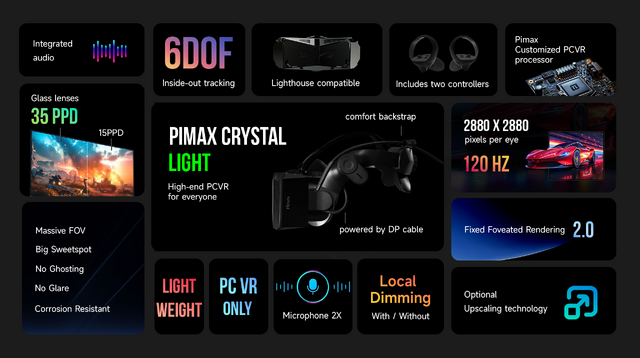
The Crystal Super, which has now been officially announced for the domestic market, is a higher-end model that further upgrades the Crystal, while the Crystal Light is a model that has a lower price while maintaining the same image quality.
Crystal Light retains the 2880 x 2880 resolution and aspherical glass lenses, but omits some of the Crystal's specifications.
Specifically, what was previously compatible with both PC VR and standalone AIO (all-in-one) mode has now been made exclusively for PC VR, the standalone battery and Snapdragon XR2 processor have been removed to make it lighter, and eye tracking has been omitted.
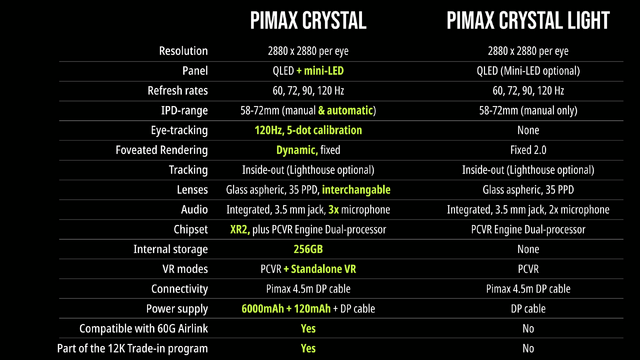
Features such as a dual-channel microphone and support for both inside-out 6DOF tracking and Lighthouse tracking remain.
This is the latest PC VR headset available for around 140,000 yen, and is aimed at people who are looking to upgrade to a new PC VR headset, or who want to enjoy their favorite games, avatars, and content with even clearer images.
Meanwhile, the Crystal Super, which is scheduled to ship in the fourth quarter of this year, is an even more high-end model, as its name suggests.
Although detailed specifications have not yet been released, a major feature of this model is that you can choose between the QLED+ mini LED model (maximum 120Hz) like the original Crystal/Crystal Light, or the micro OLED model (maximum 90Hz) (it is modular and interchangeable).
The pixel count is 3840 x 3840 per eye, 8K (or real 4K), the PPD is 50 to 57, and although the exact specifications are not available, the viewing angle is about 140 degrees, which is wider than Crystal Light.
This device is equipped with eye tracking, so the focus point is rendered in high definition and the peripheral vision is rendered at a lower resolution, reducing the load on the PC and supporting dynamic foveated rendering, which allows you to experience more luxurious images with the same GPU.
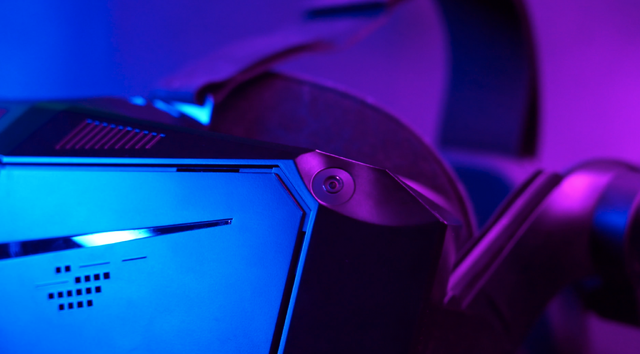
(Note that it is not completely backward compatible with the Crystal, and the all-in-one functionality has been omitted. While it would be nice to have all-in-one functionality, the proprietary Android-based OS means that there is little compatible software, and rather than being able to be enjoyed on its own like the Meta Quest, it is more like being able to "run limited demos in places where you don't have a gaming PC, and you can use the Firefox browser, etc." This may have been dropped for cost-effectiveness reasons.)
The Pimax Crystal Light model without local dimming is priced at 112,999 yen, while the QLED version with local dimming is priced at 143,999 yen. Pre-orders are already being accepted, and the product will be shipped soon.
Pimax Crystal Super is also available for pre-order, with shipments expected in Q4 2024.


